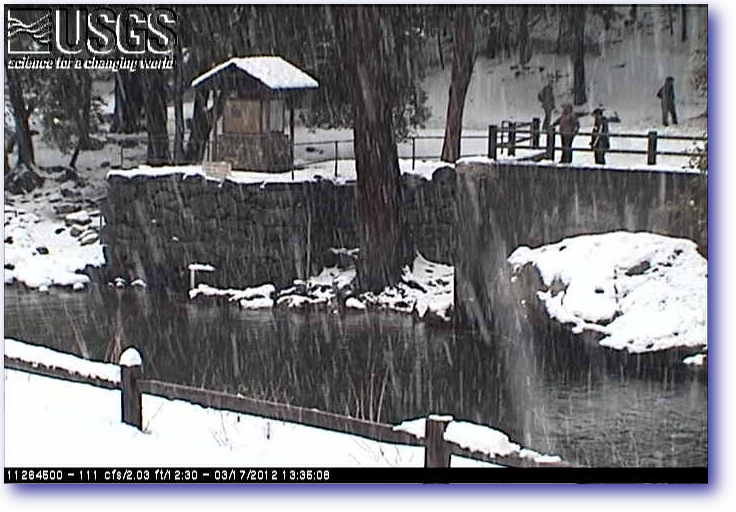The March 1st snow surveys in the Mono Basin found 33% of average snow water content to date. This is only 28% of the April 1st average, when the snowpack usually peaks.
http://www.monolake.org/today/2012/03/13/dismal-march-snow-surveys-but-a-good-forecast-for-storms-this-week/
Re: Dismal March snow surveys but a good forecast for storms this week
All posts are those of the individual authors and the owner
of this site does not endorse them. Content should be considered opinion
and not fact until verified independently.
March 14, 2012 03:52PM | Admin Registered: 16 years ago Posts: 17,140 |
|
Re: Dismal March snow surveys but a good forecast for storms this week March 14, 2012 08:14PM | Registered: 15 years ago Posts: 190 |
March 15, 2012 08:55AM | Registered: 16 years ago Posts: 423 |
March 15, 2012 01:35PM | Registered: 16 years ago Posts: 4,174 |
The weekend storm is predicted to dump snow at the lower elevations also. Wouldn't be surprised if there's snow down to Mariposa.
I'm remember back in 2006 driving to Yosemite in late February on Hwy 140 and the snow accumulation started just past Catheys Valley. Later read that the snow level of that storm was the lowest for a Sierra storm in the past 20 years.
I'm remember back in 2006 driving to Yosemite in late February on Hwy 140 and the snow accumulation started just past Catheys Valley. Later read that the snow level of that storm was the lowest for a Sierra storm in the past 20 years.
March 17, 2012 10:25AM | Moderator Registered: 15 years ago Posts: 1,634 |
And the poppies in the Merced Canyon are supposed to be putting on a good show right now.Quote
forrestranger
i have a campground reservation for the following monday... i normally go Hwy 120, but i bet i'll hit snow at that higher elevation... i think i'll go Hwy 140 instead... tuesday is suppose to be sunny.
|
Re: Dismal March snow surveys but a good forecast for storms this week March 17, 2012 10:47AM | Registered: 14 years ago Posts: 1,986 |
Quote
Dave
And the poppies in the Merced Canyon are supposed to be putting on a good show right now.Quote
forrestranger
i have a campground reservation for the following monday... i normally go Hwy 120, but i bet i'll hit snow at that higher elevation... i think i'll go Hwy 140 instead... tuesday is suppose to be sunny.
Yesterday, The Sierra Sun Times had a picture of the poppies. Beautiful. Hopefully the blossoms will not be damaged by the storm.
March 17, 2012 11:49AM | Moderator Registered: 15 years ago Posts: 1,634 |
I hope they got the name right. The Mariposa Gazette called them California poppies. They lack the peduncle between the stem and the petals. I've heard them referred to as Valley poppies, or Mexican poppies. I'm not sure which, if either, is correct.Quote
parklover
Yesterday, The Sierra Sun Times had a picture of the poppies. Beautiful. Hopefully the blossoms will not be damaged by the storm.
Edited 1 time(s). Last edit at 03/17/2012 11:55AM by Dave.
|
Re: Dismal March snow surveys but a good forecast for storms this week March 17, 2012 05:48PM | Registered: 14 years ago Posts: 1,986 |
Quote
Dave
I hope they got the name right. The Mariposa Gazette called them California poppies. They lack the peduncle between the stem and the petals. I've heard them referred to as Valley poppies, or Mexican poppies. I'm not sure which, if either, is correct.Quote
parklover
Yesterday, The Sierra Sun Times had a picture of the poppies. Beautiful. Hopefully the blossoms will not be damaged by the storm.
I have never heard the poppies called Valley poppies and could not find that name in any reference books I have.
I did find this info at enature which has one of the simplier explainations:
The Mexican Poppy is a subspecies of the California poppy.
Mexican Gold Poppy Eschscholzia californica ssp. Mexicana
Family: Papaveraceae,
Description A low, erect or sprawling, pale bluish-green plant with fern-like leaves, mostly near base, and orange-yellow, cup-shaped flowers borne singly on stalks. Habit: native annual or perennial herb; variable; colony-forming. Leaf: at base and alternate on stem, deeply dissected Flower: 4-parted cup, solid golden orange to golden yellow with orange center (rarely white or pink with orange-yellow center), 2-3 in (5-7.5 cm) long and wide, on stalk as long or longer than leaf. Fruit: narrow pod, 10-veined, to 4 in (10 cm) long, tapering to point.
Warning Can be poisonous if ingested. Sensitivity to a toxin varies with a person’s age, weight, physical condition, and individual susceptibility. Children are most vulnerable because of their curiosity and small size. Toxicity can vary in a plant according to season, the plant’s different parts, and its stage of growth; and plants can absorb toxic substances, such as herbicides, pesticides, and pollutants from the water, air, and soil.
Flower February to September, depending on rainfall and location.
Habitat Open, well-drained, sandy or gravelly places: grassy hillsides, deserts, outwash fans, flats; to 6500 ft (2000 m); also grown as an ornamental.
Range Native to Sonoran and Mojave Deserts of southwest U.S.; escaped from cultivation and naturalized throughout North America.
Discussion Also called California poppy, Arizona poppy. Considered weedy or invasive in some areas. The Spanish name, Amopalo del Campo, means "poppy of the countryside." This is appropriate, for when there are ample winter rains in the desert, this poppy grows in profusion, covering gravelly outwash fans and arid flats with a golden carpet. Once considered a separate species, Mexican gold poppy is now recognized as a desert-inhabiting subspecies of California poppy (E. californica or E. californica ssp. californica). The two subspecies are exceedingly similar, but Mexican gold poppy is native to the desert southwest, while California poppy is native to inland valleys of that state. Although California poppy always displays a prominent ring or rim underneath its flower, this structure may be inconspicuous in Mexican gold poppy. The first leaves on seedlings of Mexican gold poppy are linear and undivided, whereas on seedlings of California poppy they are divided in a Y-shape (a difference learned by careful greenhouse study).
Comments Mexican gold poppy resembles California gold poppy. It often self-sows to form large colonies. Its flowers are open in warm, dry, sunny weather, and are closed on cloudy and wet days and at night.
Exposure Preference Sun.
Native Distribution W. Texas to extreme s.w. Utah, Arizona & adjacent Mexico
Site Preference Plains & mesas; 4500 ft. or lower
Soil Preference Well-drained sands & loams or limestone.
March 17, 2012 08:56PM | Moderator Registered: 15 years ago Posts: 1,634 |
That structure is that peduncle I mentioned. The flowers in the Merced Canyon do not have one. Mexican Poppy is probably the one in the canyon. Of course, there are a few of the Calif. poppy mixed in.Quote
parklover
.... Although California poppy always displays a prominent ring or rim underneath its flower, this structure may be inconspicuous in Mexican gold poppy. ...
|
Re: Dismal March snow surveys but a good forecast for storms this week March 16, 2012 08:55PM | Registered: 14 years ago Posts: 285 |
March 17, 2012 01:37PM | Registered: 13 years ago Posts: 56 |
Sure was a pretty St Patrick's Day morning. Yosemite not showing much Green, however.
https://plus.google.com/photos/102905579299682181913/albums/5720964541021472497?authkey=CJTuwPmurrXWoQE
https://plus.google.com/photos/102905579299682181913/albums/5720964541021472497?authkey=CJTuwPmurrXWoQE
March 17, 2012 01:41PM | Admin Registered: 16 years ago Posts: 17,140 |
March 18, 2012 06:00PM | Registered: 13 years ago Posts: 56 |
Dramatic light as sun is breaking through. Can't wait to see what kind of shots the pros got today.
https://plus.google.com/photos/102905579299682181913/albums/5721403396503378513?authkey=COWg2ZKwscukOw#photos/102905579299682181913/albums/5721403396503378513/5721403395984999554?authkey=COWg2ZKwscukOw
https://plus.google.com/photos/102905579299682181913/albums/5721403396503378513?authkey=COWg2ZKwscukOw#photos/102905579299682181913/albums/5721403396503378513/5721403395984999554?authkey=COWg2ZKwscukOw
March 19, 2012 12:39PM | Registered: 16 years ago Posts: 4,174 |
Quote
Jon Mure
Dramatic light as sun is breaking through. Can't wait to see what kind of shots the pros got today.
https://plus.google.com/photos/102905579299682181913/albums/5721403396503378513?authkey=COWg2ZKwscukOw#photos/102905579299682181913/albums/5721403396503378513/5721403395984999554?authkey=COWg2ZKwscukOw
When I click on your link above, this is what I get:

|
Re: Dismal March snow surveys but a good forecast for storms this week March 19, 2012 04:19PM | Registered: 14 years ago Posts: 1,986 |
Quote
plawrence
Quote
Jon Mure
Dramatic light as sun is breaking through. Can't wait to see what kind of shots the pros got today.
https://plus.google.com/photos/102905579299682181913/albums/5721403396503378513?authkey=COWg2ZKwscukOw#photos/102905579299682181913/albums/5721403396503378513/5721403395984999554?authkey=COWg2ZKwscukOw
When I click on your link above, this is what I get:
I got the same thing.
|
Re: Dismal March snow surveys but a good forecast for storms this week March 19, 2012 06:31PM | Registered: 14 years ago Posts: 628 |
I got a 403 error yesterday but was able to see it now (stunning photo, btw...as common a viewpoint as this is, the clouds and unusual light actually had me wondering "where IS that?" for a second!).
BTW, a 403 error usually means "access forbidden" but it's issued under a lot of circumstances so it's not as straight-forward as "permission denied." About all it really tells you for sure is that the server probably found the information to which you were linking but it's refusing to transmit it for some reason.
BTW, a 403 error usually means "access forbidden" but it's issued under a lot of circumstances so it's not as straight-forward as "permission denied." About all it really tells you for sure is that the server probably found the information to which you were linking but it's refusing to transmit it for some reason.
March 19, 2012 05:19PM | Registered: 13 years ago Posts: 56 |
March 19, 2012 09:26PM | Admin Registered: 16 years ago Posts: 17,140 |
Quote
Jon Mure
eeek,
What are the steps that you use to post your Happy Isles webcam shot directly to your message, without posting a link which then has to be opened? My link works when I test it in the preview, but others always have problems opening my link.
Thanks.
Usually I just right click on the image and select the option to get its URL. Then I paste the URL into the box that pops up when I click the
Edited 1 time(s). Last edit at 03/19/2012 09:28PM by eeek.
March 20, 2012 06:03PM | Registered: 13 years ago Posts: 56 |
Sorry, only registered users may post in this forum.



